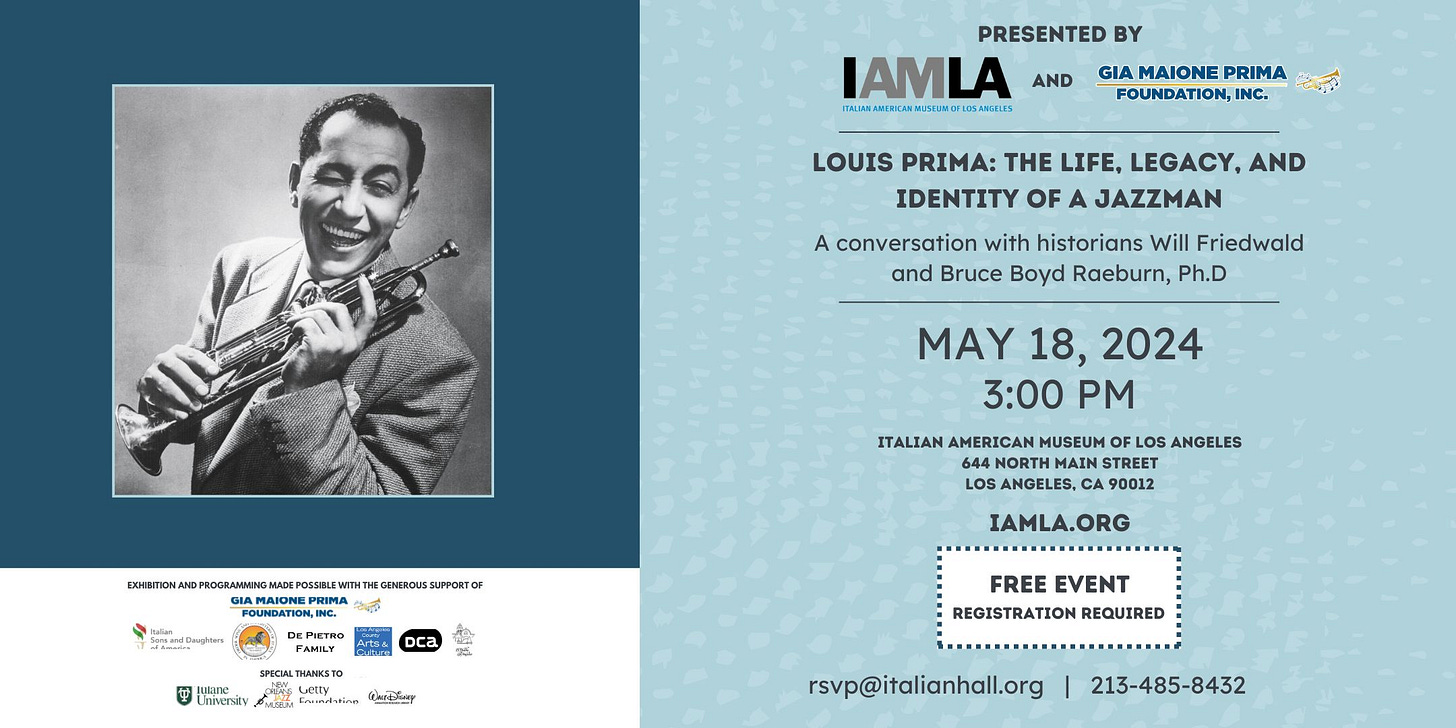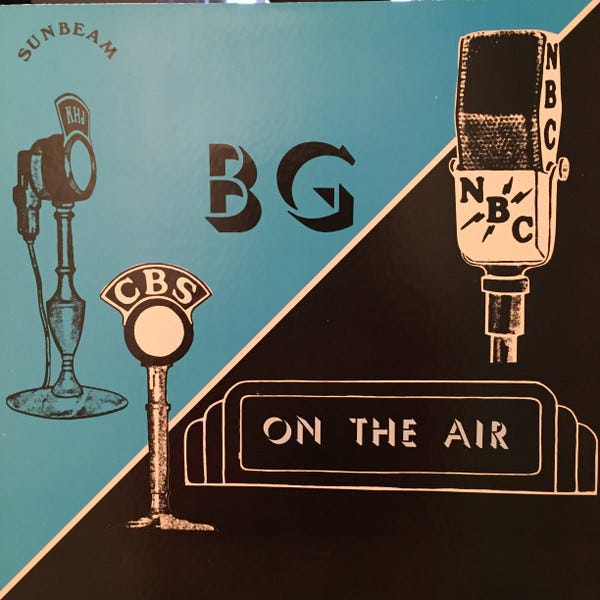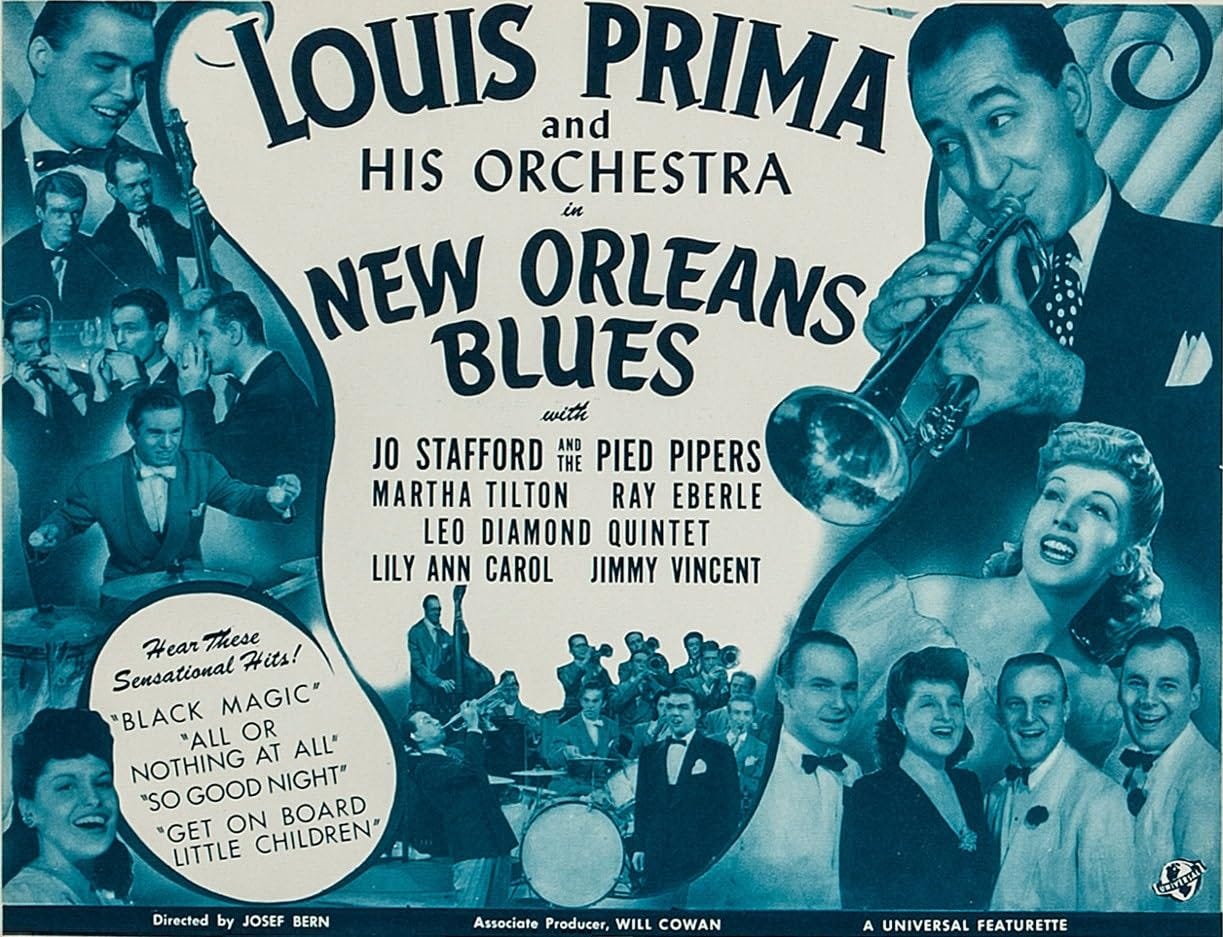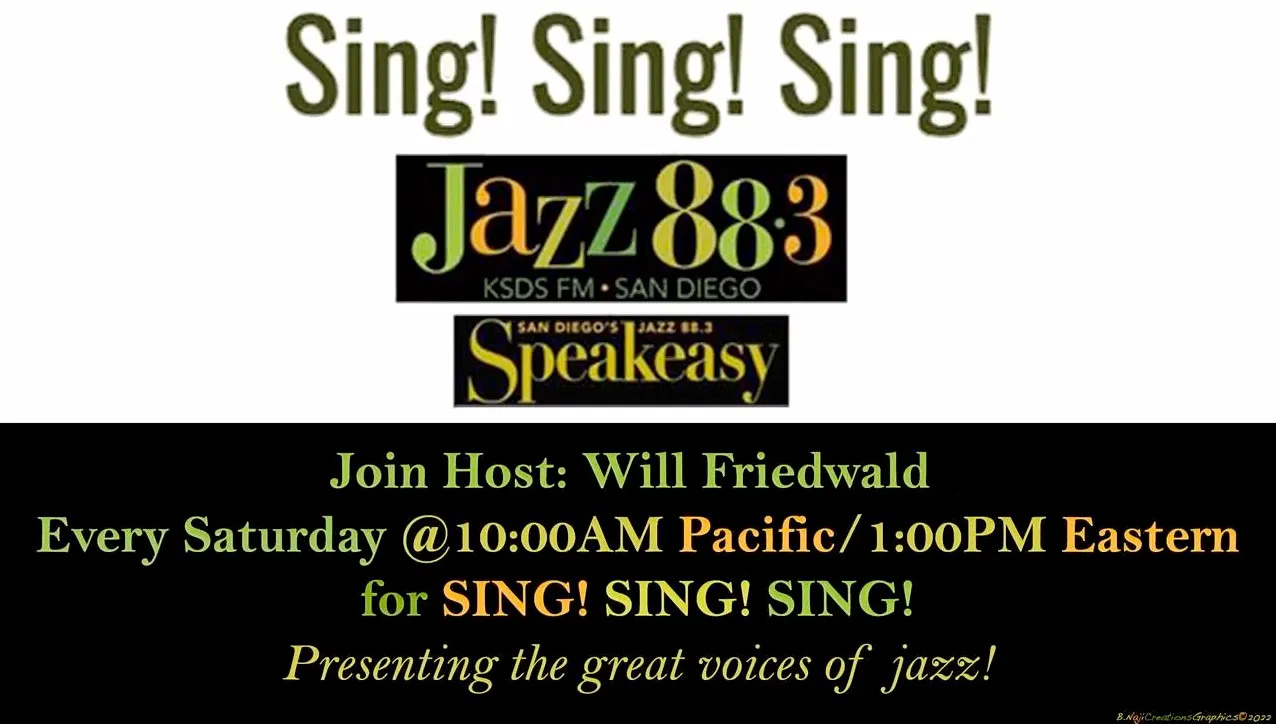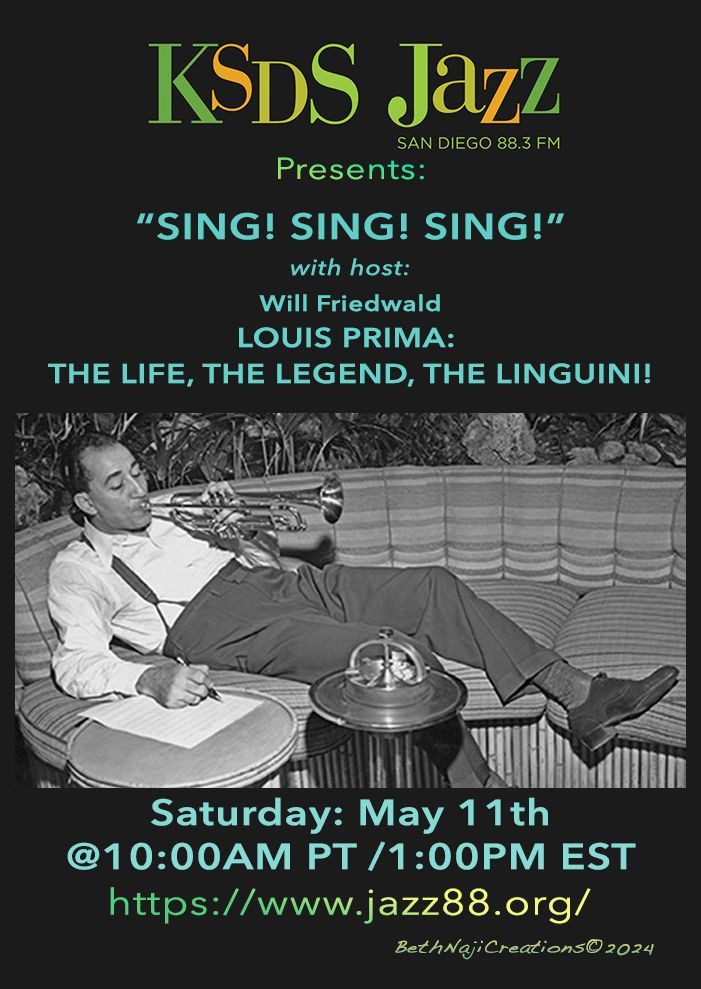Louis Prima: “Sing, Sing, Sing (With a Swing)”
And See You In Los Angeles! ("California, Here I Come")
Special thanks to the late Gia Maione Prima for many conversations - most unfortunately not recorded - many years ago, and also to Prima discographer and historian Ronnie Cannatella. (And as always, to Elizabeth Zimmer.)
My weekly radio show on KSDS San Diego (more info below) is titled Sing! Sing! Sing! Inspired by the jazz standard composed and introduced by Louis Prima in 1936, an excerpt from that premiere recording serves as our theme song.
On Saturday May 18, the brilliant Dr. Bruce Boyd Raeburn - jazz royalty in the flesh - and I are giving a talk on Louis Prima at the Italian American Heritage Museum in Los Angeles. With Prima very much on my mind - he always is - I’m doing an all-Prima episode of Sing! Sing! Sing! this week in his honor, in which I attempt a rough, highly-subjective survey of his recording career, or as much as I can cover in three hours.
I’m going to do two Slouching Towards Birdland stories on Prima’s music. Next week, I’ll talk about some of the most obscure - unjustifiably so - music that Prima ever recorded, but this time, I’m talking about the most famous thing he ever wrote. Ironically, perhaps, Prima is not known as a great jazz composer - you wouldn’t put him in the same category as Louis Armstrong, Freddie Hubbard, Lee Morgan, or Donald Byrd, who were all exceptional trumpeter-composers. Yet somehow he wrote a song that qualifies as one of the most famous in all of jazz, and - along with “Take the A Train” and “In The Mood” - qualifies as one of the definitive anthems of the swing era.
Louis Prima first established himself as a star trumpeter-vocalist-bandleader on New York’s 52nd Street in 1934 and ‘35 - and, in the process, he put “Swing Street” on the cultural map as well. Prima’s first theme song was “Let’s Have a Jubilee” by the Harlem-based pianist and bandleader Alex Hill, co-credited to publisher Irving Mills. It’s a great, jivey number, but it speaks more to the past than the present: “Jubilee” is a term associated with the old South, and the band chants “Hallelujah” in a way that comes directly out of the church.
But when he introduced the song “Sing, Sing, Sing (With a Swing),” he came up with a piece of music that was almost breathlessly new, clearly a product of the very latest thing in popular music, what we now call the Swing Era. In addition to what we might call the “serious” music of the period, there also was a trend for fun and frivolous numbers where both the band members and the audience members could sing along. This was especially true of records made for the jukebox market; it was known that those songs would be heard and enjoyed by groups of listeners in saloons, not by individual listeners at home. As Elijah Wald has noted, “Sing, Sing, Sing (With a Swing)” arrived in the wake of “The Music Goes 'Round and Around,” a huge 1935 pop hit that, no less than Benny Goodman at the Palomar, helped to launch the swing era.
About 25 years after the fact, Prima told his fifth (and final) wife, Gia Maione Prima how he came up with the idea for “Sing, Sing, Sing.” By 1935, he was already friendly with Bing Crosby and would make his feature film debut in Crosby’s 1936 starring vehicle Rhythm on the Range. Their major mutual love, beyond music, was the sport of kings. In 1999, Gia told me: “He and Bing were really close and … they were buddies and carrying on at the racetrack. Louis told me that’s how he wrote ‘Sing, Sing, Sing.’ Louis and Bing Crosby were at the track and they were winning and having a good time and Bing started singing and Louis said ‘Sing, Bing, Sing!’” Prima kept repeating the phrase, and quickly an appropriate tune came into his head.
Prima recorded “Sing, Sing, Sing (With a Swing)” on February 28, 1936, and it was immediately clear that this was a ripe anthem for a new era of music: the first major bandleaders to pick it up were Jimmy Dorsey, Bunny Berigan, and then Fletcher Henderson, before Benny Goodman started playing it in the fall. (The first known Goodman performance, on a live aircheck from Boston in September, contains a vocal by Helen Ward.) By the end of the year, it had also been recorded by local jazz orchestras in London (Teddy Foster), Paris (Willie Lewis), and Berlin (Teddy Stauffer).
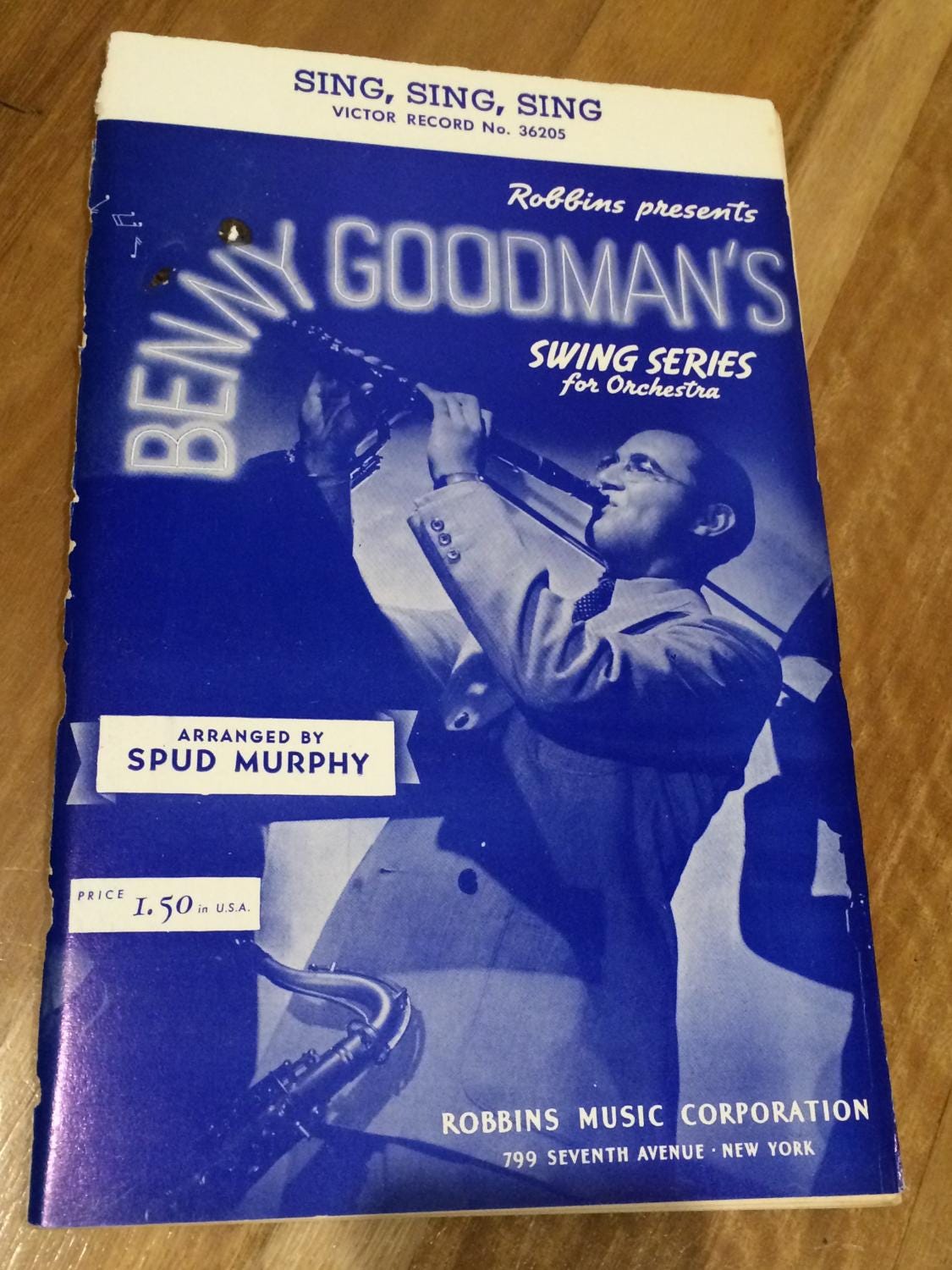
The earliest known version of “Sing, Sing, Sing” by Benny Goodman. from the"Ritz-Carlton Hotel", Boston, MA, September 18, 1936, as first issued in 1971 on Sunbeam LP-105. There is a rather awkward vocal by Helen Ward and yes, we do get the “Christopher Columbus” interpolation closer to the end. And it’s only four minutes! (Courtesy Dave Dawes.)
The story of Goodman’s iconic arrangement of “Sing, Sing, Sing” is well-documented, particularly in Russ Firestone’s excellent biography. It seems to have been the arranger Jimmy Mundy who first had the idea to expand the song into epic proportions, not least by incorporating another swinging melody (also with a nonsensical lyric) composed by another major musician of the era, “Christopher Columbus” by Leon “Chu” Berry. (Mundy also decided to put the “Christopher Columbus” melody into a minor key; when the song is heard on its own, it’s supposed to be in major.) Gene Krupa spontaneously began playing longer and longer solos and the number kept expanding, until it became the 12-minute masterpiece of Benny Goodman’s landmark Carnegie Hall Concert on January 16, 1938.
Prima was obviously thrilled by the degree to which Benny Goodman made “Sing, Sing, Sing” into a swing era perennial, particularly the landmark Carnegie Hall performance. By the end of the 1930s, the trumpeter was making a move from his small-ish group, The New Orleans Gang, to a proper big band in the BG mold. He would obviously keep “Sing, Sing, Sing” in his band book. In 1943, he starred in a Universal Pictures short subject titled New Orleans Blues - which would become the major film of the Louis Prima big band - and he included “Sing, Sing, Sing” as his finale. The band arrangement of the tune is obviously greatly inspired by Goodman, especially in the way in which the leader’s trumpet and the drummer are featured. (In addition, the band plays the earliest known document we have of Prima doing “That Old Black Magic,” which would also become one of his signature numbers.)
Three years later, Prima was in the middle of a long professional relationship with the legendary - some say infamous - record biz entrepreneur and producer El Oberstein, which would span multiple different labels: Varsity, Hit, Majestic and eventually RCA Victor. In 1946, Prima recorded his instrumental big band version of “Sing, Sing, Sing” for Majestic, again featuring Jimmy Vincent and even announcing the drummer’s name at the start. (This record doesn’t appear to be on youTube. Here’s a sound file from the private archive of the greatest collector of them all, the iconic Barry Hansen, aka “Dr. Demento.” I will also include the flip side, which is Prima’s even-more-sensational big band version of “Chinatown, My Chinatown.”)
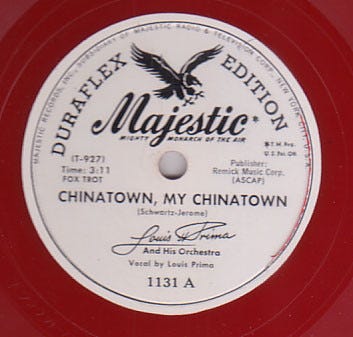
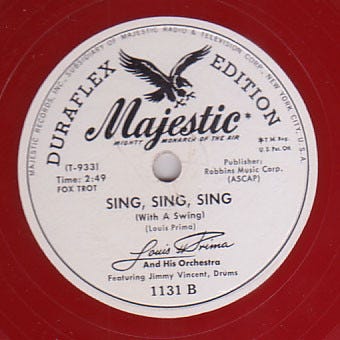
Author’s message: In 2002, Mosaic Records released a great collection of Prima’s early recordings with the New Orleans Gang (1934-1937). In 1994, Bear Family records issued the authoritative package of Prima’s Capitol sessions (1956-1962). However, there has been no package of Prima’s “middle period,” the years when he led the big band - and, as you can hear on “Sing, Sing, Sing” and “Chinatown,” this was an absolutely terrific band. A definitive collection of Prima’s big band years 1939-1954 is very much in order!
In 1958 - at the absolute pinnacle of his career - Prima recorded what would be his most famous version of his own song, accompanied by his most famous ensemble, tenor saxophonist-singer Sam Butera and the Witnesses. Although this was a small group, it maintains the flavor of both the Goodman and the Prima big band versions - but also restores the vocal, along with a particularly ingenious scat solo by The Chief, as Butera and the bandsmen called him. (This scat in particular anticipates his more famous exchange with Phil Harris on “I Wanna Be Like You” in The Jungle Book, a decade later.) Prima also plays one of his great trumpet solos of the era - as always, he was a superlative and underrated brassman - in tandem with drummer Paul Ferrara. (This was one of his many groups with Keely Smith, although her voice apparently isn’t heard on this track, which was taped in the middle of the afternoon on August 25 in the Sahara in Las Vegas.)
There are at least a few more versions, including one from 1963 that has yet to be released. For his final recording project - and his last album, The Wildest ‘75 - he returned to the song one final time. Like Woody Herman, Stan Kenton, and Buddy Rich in their ‘70s recordings, Prima was very much influenced by the progressive rock bands of the era.
The other influence on this album, and this cut in particular, was… James Bond! Butera later told Ronnie Cannatella, “The Chief told me to make it sound like a James Bond movie.” That spy movie franchise was long a powerful force in the pop music industry, and Prima was aware that the latest Bond epic, Live and Let Die, was partially filmed in New Orleans. According to Ronnie, “What you hear, according to Sam, was their version of James Bond music!!”
This final version features a lot of electric keyboard (Terry Ryan) and some very heavy drumming (Joey Vespe), as well as Butera’s tenor - and the singing voices of Sam and Gia are also both very clear.
There’s a lot more to be said about “Sing, Sing, Sing (With a Swing).” It certainly inspired elements of Artie Shaw’s “Concerto For Clarinet” and Tommy Dorsey’s “Hawaiian War Chant.’ The theme to the 1967 animated series Spider-Man is essentially a new set of lyrics (by Oscar-winner Paul Francis Webster no less) to “Sing, Sing, Sing,” even more than The Flintstones is based on “I Got Rhythm,” and Star Trek is “Out of Nowhere.” (Or is it just the Michael Buble version of “Spiderman Theme” - see below - that’s totally based on “Sing, Sing, Sing?”)
There’s a whole legacy of interpretations inspired by the iconic Goodman version; I remember a wonderfully gonzo treatment by Jon Faddis and the Carnegie Hall Jazz Orchestra with Dave Liebman playing the central solo on soprano saxophone. As we mentioned, it’s kind of amazing that a guy who wasn’t even formally regarded as a composer or a songwriter should create a jazz original that, in the 21st century, literally everybody knows. It’s even more remarkable, and especially ironic at the same time, that a song written with the explicit instructions to “Sing, Sing, Sing” - you can’t get any more specific than that - should be the most famous jazz instrumental of all.
Very Special thanks to the fabulous Ms. Elizabeth Zimmer, for expert proofreading of this page, and scanning for typos, mistakes, and other assorted boo-boos!
Sing! Sing! Sing! : My tagline is, “Celebrating the great jazz - and jazz-adjacent - singers, as well as the composers, lyricists, arrangers, soloists, and sidemen, who help to make them great.”
A production of KSDS heard Saturdays at 10:00 AM Pacific; 1:00PM Eastern.
To listen to KSDS via the internet (current and recent shows are available for streaming.) click here.
The whole series is also listenable on Podbean.com, click here.
SING! SING! SING!
May 11, 2024: LOUIS PRIMA: THE LIFE, THE LEGEND, THE LINGUINI!
May 18, 2024: “CALIFORNIA, HERE I COME”
May 25, 2024: HENRY MANCINI @ 100: “A CENTURY OF HANK!”
SLOUCHING TOWARDS BIRDLAND is a subStack newsletter by Will Friedwald. The best way to support my work is with a paid subscription, for which I am asking either $5 a month or $50 per year. Thank you for considering. (Thanks as always to Beth Naji & Arlen Schumer for special graphics.) Word up, peace out, go forth and sin no more! (And always remember: “A man is born, but he’s no good no how, without a song.”)
Note to friends: a lot of you respond to my SubStack posts here directly to me via eMail. It’s actually a lot more beneficial to me if you go to the SubStack web page and put your responses down as a “comment.” This helps me “drive traffic” and all that other social media stuff. If you look a tiny bit down from this text, you will see three buttons, one of which is “comment.” Just hit that one, hey. Thanks!



